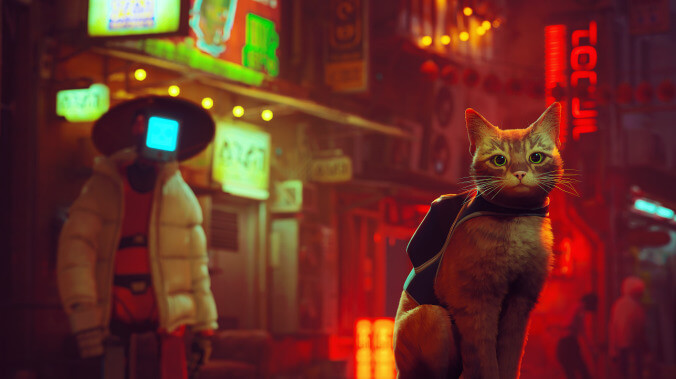Stray is short, sweet, and a must-play for cat lovers
We didn't realize such purrfect cat animations were even pawsible. Sorry. Sorry! (It's great, though)

We try not to be prescriptive here when we talk about how to play video games, there being, as the old blog title used to say, no wrong way to play. That being said, there is an objectively correct way to play Stray, the new puzzle platformer from developer Blue Twelve Studio and publisher Annapurna Interactive: With your own kitty cat curled up against you on the couch, as you navigate the game’s central character, a very capable orange tabby, through a cyberpunk dystopian world.
Because make no mistake: Stray is a game for cat lovers, by cat lovers, with the title’s single biggest selling point being the loving way your feline protagonist has been rendered and animated, every motion pulled from familiar cat movements and behaviors. (This is, as far as we know, the first ever video game to present every new carpet as a fresh opportunity for making biscuits.) Watching the cat (never named) move through the world Blue Twelve has created for it is often jaw-dropping, both in its technical execution, and its specificity. Some of the design choices can feel superfluous—your cat can, for instance, meow at any time, which is very rarely useful for stealth and not much else—but if you accept that the primary reason for playing the game is to, well, be a cat, then it’s frequently sublime. (Also, if you’re on the PlayStation, the meows come from the controller’s built-in speaker, which is an excellent way to annoy your own real-life felines.)
The world the cat inhabits, unfortunately, can’t quite match that specificity—an underground city populated entirely by robots and other cast-offs of an absent humanity, it sometimes feels kludged together from a Lego stack of ready-made video game tropes. It doesn’t help that the gameplay of Stray is fairly simple, beyond its various feline grace notes: You run, you meow, you occasionally scratch a wall, and you jump. The latter, one of your most common actions, isn’t a free leaping situation, either, but a matter of finding the right place to point the cat toward and then hitting a button to execute the leap. Exploration is still possible, sometimes even exciting, as you scour the city for collectibles and missing memories for your robotic companion B-12, and press onward toward the distant surface. But the repetition can wear: You’re going to jump on a lot of old air conditioners and leap over a lot of railings by the time the game is done. (About six or seven hours in, by our estimation, for a fairly exploration-heavy run.)
All of this, again, is ameliorated by: Cat. Whether in quiet exploration or in the occasional action scenes (which alternate throughout the game’s runtime) the cat always looks right—even if its problem-solving skills and unflagging focus sometimes defy belief as it solves puzzles, pulls levers, and avoids the deadly threats that inhabit the city.

 Keep scrolling for more great stories from The A.V. Club.
Keep scrolling for more great stories from The A.V. Club.